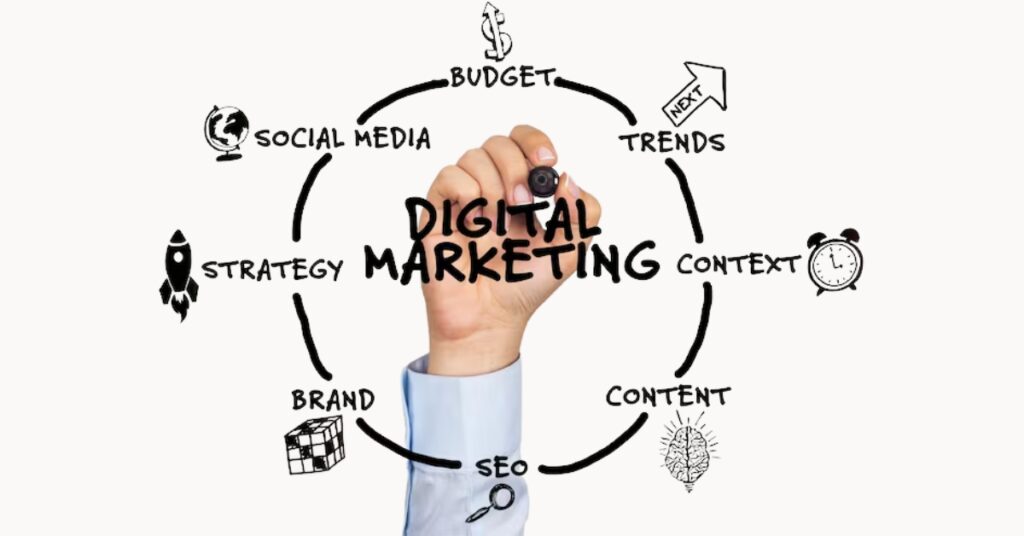10 Steps to a Digital Marketing Strategy for Small Businesses

Small enterprises cannot afford not to develop an effective digital marketing strategy anymore, as it remains a survival and growth tool. Having small funds and resources, a properly developed plan will enable making sure that all the efforts will provide quantifiable outcomes. Whether you are a beginner or you need to make the best out of your online presence, it is well-advised to follow a step-by-step process, which will help you reach your target customers.
1. Define Your Business Goals
The initial action toward developing a digital marketing plan is knowing what you desire. They are supposed to be SMART, Specific, Measurable, Achievable, Relevant, and Time-bound. An example would be to drive traffic to the site by 30 percent in 6 months, acquiring 1,000 new social media followers, or creating 50 qualified leads per month. Having specific objectives enables you to change your course of action.
2. Determine Your Target Audience
It is important to know who your ideal customers are. Carry out an elaborate market research to understand the demographics, interests, location, and purchase behavior of your audience. You need to collect data with the help of a few tools, such as Google Analytics, social media insights, and customer surveys. Not only can this help your content, messaging, and ad campaigns resonate with the appropriate audience, but you can also create buyer personas, or fictional characters, of your dream customers.
3. Analyze Your Competitors
Competitor analysis gives you the knowledge of what works and what does not work in the industry. Determine your strongest competition and research their online presence, websites, social media, content, keywords, and advertisement strategies. Such tools as SEMrush, Ahrefs, and SimilarWeb can assist you in knowing their strengths and weaknesses. This action will enable you to identify gaps in the market and of your business to be different.
4. Create a business website
Your website is the electronic shop window of your company. Make sure that it is not only conversion-friendly, mobile-friendly, but also user-friendly. Such factors as proper navigation, high loading speed, appealing images, and powerful calls to action are also important. Invest in the design that is SEO-friendly and ensure that your site identifies your brand. The inclusion of such tools as Google Analytics and chatbots will also support monitoring visitor behavior and enhance engagement.

5. Search Engine (SEO) Optimization
Search engine optimization will assist in your business being featured when the search engine results are relevant and will thus create some organic traffic. Begin with keyword research to determine what your customers are looking for. Maximize the on-page aspects of your web page that include meta titles, descriptions, headings, and content. Pay attention to local SEO in cases when you have a small business and serve a particular area, posting your business on Google My Business and gathering reviews. You should update your content frequently to remain relevant in the search engines.
6. Take advantage of Social Media Marketing
Social media sites are important in brand awareness and contact with customers. Select the sites that have the highest concentration of your target group- be it Instagram, Facebook, LinkedIn, or X ( Twitter). You have to add not only quality content but also regular content, which will interact with your followers. Combine organic and paid campaigns to attract more people. Use images, narratives, and brief videos to make it more interactive and create brand loyalty.
7. As a strategy, invest in Paid Advertising (PPC)
Pay-per-Click (PPC) advertising can achieve fast results and precision. Social media, such as Google Ads and Meta Ads, will enable you to reach a particular demographic, place, and interest. Begin small with a budget in mind and keep a check on your ad performance. Test your ad copy, creatives, and landing pages A/B in order to increase conversions. When strategically done, paid advertisements can assist in creating web traffic, raising brand awareness, and coming up with leads.
8. Create Valuable Content
Digital marketing is all about creating content as it’s king. Also, you have to create a content strategy that entails not only blogs, infographics, and video, but also social media posts. The content you produce must inform, amuse, or resolve issues for your readers. High-quality and regular content will earn your credibility and establish your brand as an authority in the industry. Look at telling stories, being real, and value addition instead of merely marketing your products or services.
9. Email Marketing should be used to develop Leads
Email marketing is one of the best customer retention tools. Additionally, gather emails by using forms or pop-ups on your websites or generating campaigns on social media, and subdivide your list by interest or purchasing behavior. Also, use personalized messages in the form of newsletters, product updates, or offers to keep your audience interested. You can use automation software, such as Mailchimp or HubSpot, to organize your email campaigns and determine their success.

10. Measure, Analyze, and Optimize
Digital marketing is an ongoing process. You have to measure your performance with the help of these tools, such as Google Analytics, Search Console, and social media insights. Indicators that you will measure are web traffic, engagement level, click-through rate (CTR), and conversions. Measure what is working and what is not, and make some data-oriented changes. Optimization is something that should be done on a regular basis so that your campaigns are relevant to your business objectives.
Bonus Tip: Concentrate on Consistency and Brand Identity
The same thing applies in every channel of marketing. Make sure that your brand voice, colors, and message are consistent. It can be your site or social media updates, or email messages; either way, consistency creates awareness and trust. A robust and well-unified brand identity makes the customers remember you and prefer your business over others.
Conclusion
The construction of a digital marketing strategy is planned, hard, and involves optimizing work on a small business. With these 10 steps in place, as defined by goals, audience knowledge, website optimization, SEO, and good content, you can build a solid presence on the Internet and find loyal customers. To get to know how to practically use these strategies and acquire a real-life experience working with real-life projects, you can consider becoming a part of Digi Edu Learning, where online digital-marketing programs taught by experts can teach students and professionals how to implement the theories in practice and how to develop specific practices that will result in actual business outcomes.







Leave a Reply